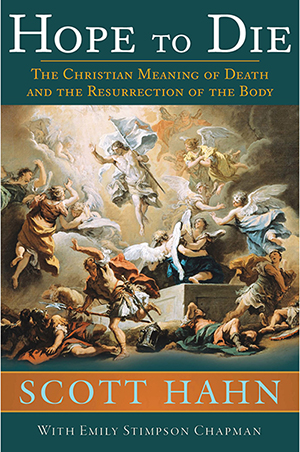Scott Hahn’s book ‘Hope to Die’ challenges how we live in and treat our bodies

Reviewed by Matthew Vander Vennet
When my Grandpa Vander Vennet uttered his final breath, it was the first time I had been present as a soul was leaving its body. It was the final note in the song of a life well lived.
We had known the end was approaching and had made sure that Grandpa was comfortable. We sang his favorite songs and kept on telling him how much we loved him. We thanked him and we cried. Being there in his final moments on this earth was one of the most sacred and beautiful things I have ever experienced.
Dr. Hahn and Mrs. Chapman have done a service to the Church at this juncture in time. This book will change the way you think about your body and your actions with it or prompt you to consider things you have forgotten.
Living, dying, and its Christian meaning is the subject of Dr. Scott Hahn’s newest book, “Hope to Die: The Christian Meaning of Death and the Resurrection of the Body,” with Emily Stimpson Chapman. In his usual style, wit, and manner Dr. Hahn once again sheds light on something I daresay most of us do not actively think about.
We should. Life and death mean something greater to the Christian. “How we treat our bodies in death matters. . . . We were not made for death. We were made for life.” (p. 7)
WHAT WE DO WITH OUR BODIES MATTERS
A popular error of our own age is that we are “ghosts in the machine” and that what we do with our bodies doesn’t really matter. That idea could not be further from the truth. We are not just souls with bodies; we are body-soul composites. Wherever we go after death — whether that is heaven, purgatory for a time, or hell — the fact remains, and our faith teaches us, there will be a general resurrection of the dead at the end of time and bodies will reunite with souls to their eternal reward or damnation. What we do with our bodies matters.
Hahn begins his discussion by fleshing out what is meant by the words “life” and “death” and what that implies. In perhaps my favorite chapter (2), he explains that the body is the sacrament of the person.
As Catholics, we know that sacraments are efficacious outward signs of inward realities. Each of the sacraments that we have received throughout our lives has an effect on our bodies and our souls: we were washed in the waters of baptism and incorporated into the Church; we have consumed the Eucharist and held Christ within us; we have inclined our ears to hear the words of absolution after confession; we have exchanged our person with our spouse in matrimony; our hands have been anointed to act in Persona Christi in Holy Orders; and we have been sealed by chrism and the Holy Spirit in confirmation and the anointing of the sick.
After these experiences it is wrong, indeed it is a sin, to treat our bodies with contempt or as ancillary to who we are as a person, especially after death.
REVERENCE FOR THE DEAD
Christ coming in the flesh was always meant to renew the image of God in Man. “That union gave new value to every other human body” (p. 26) and has implications across the dividing line between life and death. Reverence for the dead stretches across salvation history from Genesis to Tobit to Revelation. Having respect for the dead and their bodies points to the reality of the bodily resurrection to come. “What happens to bodies matters. How bodies are buried matters.” (p. 50)
Christ’s Resurrection is the crux of everything. His coming was to bring about the resurrection of our bodies. His goal for us was and is eternal life in heaven and our bodily resurrection. His resurrection is the “divinization of his humanity. It’s the created passing into the uncreated, the temporal entering into the eternal.” (p. 68) Our resurrected bodies will be like His resurrected Body. If we have feasted on His resurrected Body via the Eucharist, we become like Him — a reversal of what happens when we normally eat food and it becomes a part of us.
As Scott Hahn states, the body is “the bridge that allows others to know us.” We must treat it accordingly because the many graces we have received linger even after death. The body is the place time and eternity meet in this life. How awesome and humbling a reality.
God-willing, when we get to heaven and are reunited with our bodies at the end of time, our bodies will be glorified like Christ’s, our bodies will be “home at last.” There, according to Hahn, we will share stories with one another and never tire of hearing them and the ways that God operated in our lives and how each and every person’s story was connected to one another. We’ll know the prayers prayed for us, their effects, and the effects of our own prayers on others’ lives. “. . . [E]very person’s body will radiate the truth of the person and the truth of their story and the truth of the Greatest Story ever told.” (p. 107) In light of this, it is inconceivable to view the body as less than it truly is.
Christ’s followers radically changed humanity’s perception of death. Christians buried their dead as Christ had been buried and treated the mortal remains as something sacred; indeed, they are. From this understanding comes the way we treat and venerate our brothers and sisters in the faith who have gone before us. Why do we treat the relics of saints as we do? Because their entire person has been made holy by Christ. “[C]atholic veneration of relics [is] bound up with its understanding of the body and the human person.” (p. 124) Bodies are laid to rest in wait for their reunification with their soul.
BELIEF LEADING TO ACTIONS
Hahn describes how the body was viewed throughout history and the stark contrast to how it is viewed now. Unfortunately, the practice of burying the dead has waned, even among Catholics. Cremation has taken on a new popularity and the understanding of the body and of death has been clouded as a result. The Church “does not approve of cremation; it permits it.” (p. 153)
Burial remains the most fitting way to care for the body until the general resurrection. Cremation speaks one way about death, burial another and “which truth we believe has implications not just for our death, but for our life.” (p. 154)
At the heart of it all is the implication of God’s love for humanity and how we reflect that knowledge in the manner by which we treat the living and the dead. If we truly believe what our faith teaches, then it naturally and lovingly should manifest itself in our actions. Treating our bodies as they should be treated speaks to our beliefs and our faith in our own resurrection and the promises of Christ.
As Hahn states, the body is “the bridge that allows others to know us.” (p. 160). We must treat it accordingly because the many graces we have received linger even after death. The body is the place time and eternity meet in this life. How awesome and humbling a reality. These realities should stop us in our tracks and cause us to marvel at our lives and ponder what we do in our bodies. It is only fitting that they should see resurrection at the end of it all.
Dr. Hahn and Mrs. Chapman have done a service to the Church at this juncture in time. This book will change the way you think about your body and your actions with it or prompt you to consider things you have forgotten. May we all hope to die.
—
 MATTHEW VANDER VENNET is director of advancement and development at The High School of Saint Thomas More in Champaign and a member of The Catholic Post’s book review team.
MATTHEW VANDER VENNET is director of advancement and development at The High School of Saint Thomas More in Champaign and a member of The Catholic Post’s book review team.





